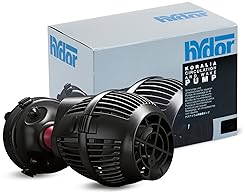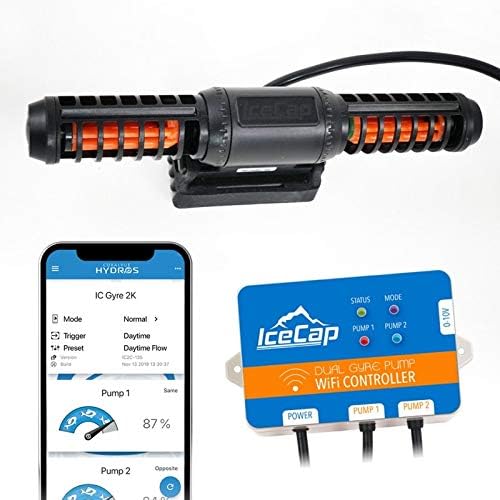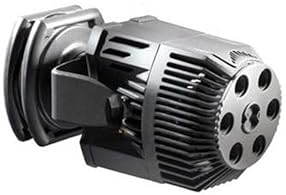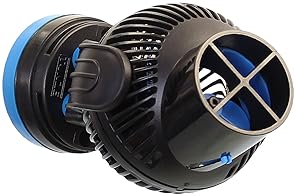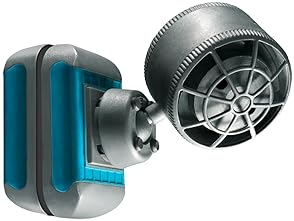When I first got into aquariums, I didn’t quite get the point of wave makers.
Why should I spend good money on something that seems pointless? There won’t be any surfers in my tank, so thanks but no thanks.
But then it was pointed out to me by some patient veterans that wave makers and powerhead units are actually beneficial in several ways, and that’s why they’re often a regular part of any aquarium.

(source)
Benefits of a Flow Pump
Positioning your Wave Maker
Factors to Consider when Buying Wave Makers
Types of aquarium water pumps
Top-rated Aquarium Wave Maker Reviews
Now that we know what to look for, let’s turn our attention to some likely prospects:
1. Jebao OW with Controller for Marine Reef Aquarium
Jebao OW Wavemakers are the latest version of their wave-maker series of flow pumps.
Originally designed for reef aquarium containing corals and other invertebrates, the Jebao OW water pumps are equally functional at home in planted aquariums.
The latest improvement to the line includes a switch from two-pole magnet impellers to four-pole units. This improvement will make the pump quieter and increase torque and water flow, while still maintaining a small pump size.
Previous models had electronic control components inside the motor housing. With the OW series, they’ve been relocated in the external controller.
The water pumps are held in place with a magnetic through-the-glass mount. The OW series allows for greater rotation and aiming of the flow output.
The pump has eight different pre-programmed flow rates. The pumps can be individually controlled or linked with the wireless controller for synchronizing several pumps and their flow patterns.
The automatic “night-time sensor” detects when the tank’s lights go off, slowing the pump flow rate. A 10-minute feeding timer makes feeding easier. You also get several wave pattern modes that mimic reef wave action.
Available in 4 models to suit nano reef tanks to larger freshwater and marine aquariums.
- OW-10: 132-1056 GPH, Dimensions: 3.25″ x 2.25″ Diameter
- OW-25: 184-2245, Dimensions: 3.74″ x 2.75″ Diameter
- OW-40: 317-3962, Dimensions: 4.52″ x 3.54″ Diameter
- OW-50: 449-5283, Dimensions: 3.70” x 4.72” Diameter
Pros
- Improved 4-pole impeller design.
- Wireless control.
- Multi-pump control.
- Pre-programmed flow rates and modes.
Cons
- Budget build quality to reduce cost.
- Some pumps are noisy right out of the box.
- Long-term reliability remains to be seen.
2. Hydor Koralia Evolution Circulation Pump
The Koralia Evo line of water circulations pumps has recently undergone three redesigns over the past few years.
This model is the second-generation design and looks like the best one so far.
The third generation EVO circulation pump seems to have reliability issues that need to be worked out. Here’s what I like about it.
The shaftless impeller design is reliable and coupled to an energy-efficient motor. The water flow created by the impeller is high volume but not abrasive.
The idea behind the Evo is move a lot of water without “power washing” your corals and freshwater plants. That is the downside of traditional powerheads. They're big, bulky, make a lot of heat and blast water in a very narrow flow pattern.
The Koralia Evolution circulation pump has a sturdy cage that keeps debris, snails, plant leaves, and other aquatic life away from the spinning impeller. The cage design also allows the pump to keep working even if a leaf or algae partial clogs a portion of the cage.
The magnetic mount holds the pump securely and lets you aim the water flow anywhere it’s needed in the aquarium.
The pump can be used as a stand-alone unit or teamed to the Smart Wave Circulation Pump Controller. The controller can run two water pumps. There are two modes types of pump control. The Alternate mode turns Pump 1 ON – Pump 2 OFF then Pump 1 OFF - Pump 2 ON. The Synchronous mode turns both pumps on and off at the same time. The controller also allows you to choose the time interval between the automatic switching of the two modes. The range is five seconds to six hours.
There are four models in the second-generation line-up, suitable for nano tanks to full-size reef and freshwater aquariums.
- Model 600: 600 gph, Dimensions 2-7/8" x 5-3/4" Rated for 40-70 gallons FW, 25-40 SW
- Model 850: 850 gph, Dimensions 2-7/8” x 5-3/4” Rated for 50-90 gallons FW, 30-50 SW
- Model 1150: 1,150 gph, Dimensions 2-7/8” x 5-3/4” Rated for 70-125 gallons FW, 45-70 SW
- Model 1500: 1,500 gph, Dimensions 2-7/8” x 5-3/4” Rated for 90-160 gallons FW, 55-90 SW
Pros
- It’s another budget model, yet many also love the value it offers.
- It’s very easy to set up.
- It stays where you put it. That’s thanks to its excellent magnetic suction cup and its vibration-absorbing tech. It doesn’t “walk” from its original spot.
- It’s very quiet, so when in use in your bedroom it won’t disturb your sleep. You’ll only hear something if you’re about 4 inches near the aquarium wall.
- The compact design means it doesn’t take much space in your tank.
- The ball joint allows for easy directional adjustment, and you can even remove the head for some quick cleaning.
- It’s also quite sturdy.
- The controller can control many pumps, it’s splash-resistant, and it’s easy to use. It also comes with a hanger so you can mount it on a wall.
- The Hydor customer support does its job.
Cons
- It makes some sort of clicking sound when you turn it on.
- You only get 2 different water movement programs, plus a feeding program.
3. Reef Octopus Octo Pulse Wave Pump
Reef Octopus, best known for their protein skimmers and return pumps, has entered the wave pump field.
The Octo Pulse line is designed around a propeller pump enclosed in a cage.
The pump motor sits inside the aquarium. It is held to the glass with a magnetic mount.
The Octo Pulse has a 25-degree adjustability for aiming in the aquarium. The pump body can be rotated 360-degrees.
Intended for the reef aquarists, these pumps can be used in freshwater aquariums too.
The OctoPulse is wired to a controller that has four pre-programmed flow modes. These include Constant, Stream, Tide and Random.
The controller can be used to increase the flow rate. The feeding mode can be set to 15 or 60 minutes. There are eight flowrate presets to choose from.
There are two Octo Pulse available as OP2 and OP4 models. The OP2 is too powerful for smaller nano reef aquariums. The Octo Pulse line of circulation pumps have basic features without wireless control or advanced programming options.
- Reef Octo Pulse 2: flow rate 845 - 1585 GPH, tank range 21-80 gallons.
- Reef Octo Pulse 4: flow rate 1410 - 4490 GPH, tank range 80-475 gallons.
Pros
- Two-year warranty on pump.
- Ceramic shaft and bearing.
- Quiet with soft-start feature.
- Pump will shut down if jammed.
Cons
- Limited flow patterns.
- No wireless control.
- Poorly-written manual.
4. IceCap Gyre Flow Pump
Reef aquariums require a constant flow of water to sustain healthy coral growth.
Traditional wavemakers and powerheads focus water flow in a narrow pattern that only affects small sections of the reef.
Often times, powerheads are too strong for direct contact with corals and must be pointed away from the reef, leaving low-flow zones that stagnate.
The Icecap Gyre Generating Flow Pump uses “crossflow technology” to circulate a large volume of water throughout the entire reef without creating high-pressure “hot spots” that damage corals and other invertebrates.
The Gyre system moves aquarium water in a horizontal pattern across the reef. The waterflow contacts the opposite side of the aquarium and circulates back toward the pump. This is called a gyre flow pattern. The wavemaker is controlled by the Gyre Advanced Controller.

It comes with an OLED display for easy set-up and programming. The Gyre comes pre-programmed with five water movement modes: Pulsing, Gradual Pulsing, Constant Speed, Random Pulse and Alternating Gyre (requires a second pump unit).
The IceCap also includes a 10-minute feeding timer that reduces water flow while you feed your corals. The water pump can also be programmed to ramp up and down over a 24-hour period, mimicking tidal flow patterns.
The IceCap 2K is rated for aquariums from 20 to 90+ gallons, the 4K size is recommended for tanks 25 to 150+ gallons.
The 1K size, rated for tanks 20-50+ gallons is also available.
Pros
- Magnetic mounts make placement easy.
- Moves a lot of water.
- Eliminates hot spots.
- Flushes the reef with water.
- Helpful presets, no programming necessary.
- 24-hour timer feature.
- Feeding mode.
Cons
- Pump can create a slight whine noise.
5. EcoTech VorTech Marine Wireless Wavemaker
EcoTech Marine developed the first controllable water circulation pump that placed the motor outside of the aquarium.
EcoTech offers four models of magnetically-coupled propeller pumps, suitable for a wide range of aquarium sizes.
There are no electrical wires in the aquarium. Vortech pumps use QuietDrive motors, that are magnetically coupled to the pump housing inside the tank.
This engineering feat eliminates the problem of stray voltage leaking from traditional “potted” power heads and submersible pumps. It also prevents heat generated by the drive motor from being transferred to the aquarium water.
This is a great feature for nano aquariums with a small volume of water and large tanks with intense lighting.
The Vortech pumps come with a wireless controller that contains pre-programmed flow modes. You don’t need to do anything except plug in the pump to get it up and running.
EcoTech was the first to create reef-specific water flow modes.
Water flow modes:
EcoTech Vortech pumps are available in four sizes.
- MP10QD (no wireless control): flow 1,500+ gph, tank range: 2.5-50+ gallons
- MP10wQD: Same as MP10QD but with wireless control
- MP40wQD: flow 4,500+ gph, tank range: 50-500+ gallons
- MP60wQD: flow 7,500+ gph, tank range: 120-1,0000+ gallons
Pros
- US-made.
- Customer tech support is located in Pennsylvania.
- Constructed with high-quality materials.
- Quiet, dependable operation.
- Can be used with EcoSmart Live automation software.
Cons
- None.
6. Sicce Voyager Power Stream Pump
Sicce has a long history or manufacturing high-quality water pumps for the aquarium hobby.
The Voyager Stream Pumps is Sicce’s take on aquarium circulation pumps. You’ll immediately notice the design looks quite different than the typical “caged impeller” circulation pumps.
The business end, where the water comes out looks more like a Gatling machine gun than water pump.
The water outlet is a series of ports arranged in a circle. The ports don’t spin but they do serve a purpose. Water flow can be reduced by turning the pump outlet, which closes the ports.
So, what’s the big deal? The Voyager Stream Pump sends out a high volume of water (adjustable) in a wide flow pattern.
Unlike power heads and some circulation pumps, The Voyagers won’t blast water on a small spot in your reef or planted aquarium.
The Voyager Stream Pumps start up in the proper rotation, eliminating noisy chatter. The pumps attach to the aquarium with the usual magnetic through-the glass mount.
Sicce uses strong magnets and high-quality rubber to survive in saltwater without becoming hard or brittle. The Pumps have a 180-degree aiming radius.
One important note. The pump is cradled in a yoke. The wingnut that locks the pump in the cradle can be over-tightened, distorting the pump body. This can cause a clicking noise. Don’t over-tighten the wingnut! These are basic set-it and-forget-it water pumps.
They have no programmed modes or wireless controls. But you can control them with the Sicce Wave Surfer controller. Water movement adjustment is possible by setting switching intervals, 4-minute feeding mode and 8-hour slow0flow night mode settings.
Sicce Voyager Stream pumps are available in three sizes:
- Voyager 2: 800 gallons per hour
- Voyager 3: 1200 gallons per hour
- Voyager 4: 1600 gallons per hour (rated for tanks 125 gallons)
Pros
- Reliable start-up.
- Quiet.
- Good flow rate.
- Can be used with a basic controller.
- 3-year warranty.
Cons
- All pumps are the same size: 5.95” x 3.2” x 3.05”.
- Too bulky for a small nano tank.
7. Aqua Illumination Nero 5 Submersible Wave Pump
Aqua Illumination, an Iowa-based reef lighting manufacturer, has entered the wave-maker market with their Nero 5.
The Nero 5 is small, measuring only 2.8 inches across and 2.1 inches deep.
AI’s slogan for this water pump is “brains and brawn.” As for brawn, this little pump can create up to 3,000 gph.
But you can also dial the flow down to 1%. This means this tiny pump is at home in a 15-gallon nano reef or in a huge reef aquarium requiring several Nero 5s to keep the water moving.
The flow pattern is wide, meaning it won’t create “hot spots” in your reef aquarium. So, I vote Yes for brawn.
But what about brains? AI took a minimalist approach with this smart flow pump.
The only wired connection is the power cord. You control the AI Nero 5 with an easy to use app.
The good news is you don’t need an internet connection. The AI app runs on the latest Bluetooth LE. This new Bluetooth standard does away with annoying discovery and pairing. The Nero 5 is instantly recognized by the myAI smartphone app.
Setup is painless. You can immediately set up the Nero 5 right from your smartphone.
You can choose from three flow modes. Constant Speed is an always on setting with control over pump speed. Pulse creates uniform high and low wave forms. Random simulates irregular wave action.
The myAI app has drag and drop capability for easy programming. You have full customization ability of up to five Nero 5 wave pumps. You can even schedule a feeding mode.
All these flow patterns are designed to appear to reef aquarists with SPS and LPS corals, where lots of water flow is desirable.
The Nero 5 attaches to the aquarium with a magnetic mount. You can use it on aquarium glass up to 13-mm thick. The pump is rotational for aiming.
Pros
- Small size, fits anywhere.
- Powerful flow that can be adjusted for small nano reef aquariums.
- Easy to control with the myAI app.
- Works with other smart lights and return pumps.
- Quiet operation.
Cons
- Magnetic mount may not be strong enough for thick 15-mm glass aquariums.
8. Maxspect Gyre Wavemaker Pump
Maxspect created the game-changing gyre pump and changed the way we think about water flow in our reef tanks.
Old-fashioned powerheads and even modern circulation pumps use propeller-style impellers to move water.
With these designs, water velocity strongest close to the the pump but falls off quickly.
This can lead to low-flow areas at the far side of the reef tank, especially within rockwork.
The Maxspect XF330 creates what’s called a gyre flow pattern. The unique impeller design pushes the water in a horizontal flow across the aquarium. The wave energy hits the opposite side of the aquarium and bounces back toward the pump. It’s been described as a “conveyor belt of water.”
The Gyre’s impeller is housed in a long cage. This design moves a lot of water without creating those high velocity “hot spots” that blast away at corals. The Big Idea is to keep all the water in the aquarium moving, not just a few spots where the pumps are aimed.
Many reef aquarists feel the gyre action provides a more natural and thorough flushing of their reef tank. The Maxspect gyre pumps are available as the XF230, XF280, XF330 and XF350. All pumps can be controlled with the Gyre Advanced Controller. Note that the 2XX series controller is not compatible with the 3XX units and vice-versa.
It comes with a high definition OLED display that uses colored icons. This makes for easy to set up and programming.
You can also use the wireless control with Apple and Android apps.
The Gyre Advanced Controller comes with five water movement modes: pulsing, gradual pulsing, random pulse, constant speed and alternating gyre (requires two pumps).
- XF230: 2100-2300 GPH, rated for 25-100 Gal tanks, 10” × 2.95” × 1.57”
- XF280: 21,000-22,500 GPH, rated for 200-1,000 Gal tanks, 14.8” × 3.8” × 2.0”
- XF330: 2350 GPH, rated for 25-120 Gal tanks, 10.5” × 2.6” × 1.3”
- XF350: 5280 GPH, rated for 80-800 Gal tanks, 12.8” × 3” × 1.5”
Pros
- Unique gyre water flow.
- Designed for reef aquariums with live rock and corals.
- Slim profile in the aquarium.
- Programmable.
- Long cables for easy installation.
Cons
- Some aquarists say their can hear the motor hum when using pulsing modes.
- Firmware and reliability issues on the 3XX series.
9. Current USA eFlux Wave Pump Kit
The eFlux Wave pump comes complete with a remote control feature.
The eFlux Kits uses a quiet, propeller style wave pump that is regulated by the LOOP Pump Controller.
The wireless feature controls water flow speed and circulation patterns that mimic natural reef currents.
The Wave Pulse Mode simulates pulsing wave action.
The pattern consists of alternating speeds from 0.2 to 7 seconds. The flow adjustable from 20% to 100%. The Surge Mode simulates surging water currents.
The Gyre Mode synchronizes two wave pumps for gyre flow. Stream/Steady Mode creates a steady flow of water current. The Feed Mode turns pumps off for 10 minutes for coral and fish feeding. This prevents the food from being pulled into the water overflow, skimmer, and filter system.
The eFlux water pump uses the LOOP feature. LOOP is Current’s connectivity hub device, which allows you to connect and control other Current equipment remotely.
Pros
- Magnetic mount for easy aiming.
- Easy to set up the wireless controller.
- Simple to use pre-programmed wave settings.
- Will control several water pumps.
Cons
- Uses proprietary power plugs.
- Controller only compatible Current water pumps.
10. Tunze USA NanoStream 6045
The Tunze NanoStream circulation pump has several features that set it apart from other circulation pumps.
This miniature water pump has a diameter of only 2.75 inches.
But don’t be fooled! The NanoStream pumps out a flowrate of 1189 gph.
The Tunze water pump is energy-efficient and uses only seven watts.
The NanoStream design uses a very large strainer for the intake. This prevents snails, fish, and debris from getting caught in the impeller. The large strainer reduces the concentrated suction around the intake so marine life won’t get pulled into the pump. The spherical shape coupled with a flow adjustment creates a three-dimensional water flow.
The NanoStream 6045 won’t blast your corals off of the live rock. The water flow is easily aimed and the magnetic holder keeps the pump securely mounted to the glass. The circulation pump comes with a magnetic holder (works on up to 1/2" glass thickness), which enables uncomplicated attachment at any position on the aquarium pane.
The Tunze NanoStream 6045 is rated for aquariums between 10 and 135 gallons.
Pros
- Simple design.
- Quiet operation.
- Strong magnetic mounts.
- Reliable Tunze motor.
- Small size with good flowrate.
- Long power cable (6.7 feet)
Cons
- The 6045 NanoStream is not compatible with controllers.
11. TAAM Mini Polario 10ML Low Voltage
TAAM, famous for their Rio water pumps, has introduced this unique wave-making circulation pump.
The Polario series of circulation pumps use low voltage for safety.
An automatic controller periodically reverses the flow rate of the pump. This means the Polario is bi-directional.
The pump creates the back and forth water surges found on a natural ocean reef. Instead of using two water pumps, the Polario system just reverses the pump impeller rotation to create opposing water surges.
The program works like this: Flow settings: 50% power 5 seconds, 75% power five seconds, 100% power 5 seconds and then a
The identical cycle then begins from the opposite side. The flow rate varies from 1,500 to 2,600
The screen around the pump could be a little tighter to prevent snails and small fish from getting too close.
Pros
- Bi-directional outputs simulate the natural waves and currents of the ocean.
- Quiet operation.
- Tiny size - 2.1" x 2.4".
- No programming needed.
- Only one water pump is needed to create wave action.
- Fits behind live rock.
Cons
- The wave cycle and flow rate are not adjustable.
- Not compatible with other controllers.
Final Recommendations
There are a lot of wavemakers and in-tank flow pumps to choose from. Selecting the right one can be a challenge. I’ve created several recommendations based on the type and size of the aquarium. This will really help you narrow in on the best wave and flow pump choices for your specific aquarium.
Nano reef aquariums
The great thing about tiny reef tanks is you can now keep SPS and LPS corals in the small footprint of today’s nano aquariums. The problem of properly-sized lighting and filters has been solved. The same goes for wave pumps.
The gold standard for tiny flow pumps are the EcoTech Marine MP10QD (No wireless control) and MP10wQD. They’re perfect for tanks in the 2.5 to 15-gallon range. The AI Nero 5 is also a contender and is a great flow pump for planted aquariums. The ability to dial the pump flow way down is a huge advantage, especially with smaller aquariums.
Mid-sized reef aquariums and planted tanks
When you’re in the 20 to 65-gallon range of reef tank, a larger flow pump will be necessary.
The Maxspect Gyre pumps (2xx series) have proven themselves to be effective and reliable. The ability to get all the aquarium water moving and flushing across corals and live rock is a big plus. Corals respond positively when given the right water movement.
The Maxspect Gyre make fine-tuning flow patterns easy, through the pre-programmed controller. The gyre flow pattern is also very attractive in planted aquariums. The gyre eliminates the “power washing” effect of power heads. Your plants won’t be pushed over from abrasive currents.
The Hydor Koralia Evolution series of pumps also deserves consideration. These pumps use the more traditional approach of point-and-shoot wave makers.
Large reef aquariums
It’s no secret that large tanks filled with live rock, SPS and LPS corals and other inverts require several flow pumps to get the water moving. It’s more difficult to set up a flow that reaches all the corners of the reef. Here’s where the larger, more powerful wave makers really shine.
The Sicce Voyager Stream Pumps offer plenty of power without a lot of high-tech features. One or two of these may be all you need to achieve your goals.
If aquarium automation is your thing, the larger EcoTech Vortech pumps are proven performers.
The AI Nero 5 is relatively new, but these tiny pumps really move a lot of water. Their small footprint and multi-pump control capability makes it easy to use several Nero 5s, without taking up a lot of room.
Of course, if you have a different opinion, feel free to chime in with your comments!

